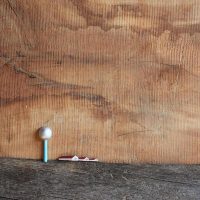Having used a more provocative material in his aluminum sculptures, Balázs Csepregi goes back to a more traditional material, searching for new expressive potentials in wood. In his works he presents familiar scenes and forms that can be recognized as reflections on nature. The starting point of Csepregi’s art is everyday life in the countryside: e.g. Kossuth Street presents a view of a street in a village. Although the sculpture seems to be playful at first glance, its monochrome shades and the complete absence of any human presence makes it somber. The row of houses reminds the viewer of Hungarian villages consisting of a single street, in which the geometric simplicity of the buildings can be traced back to the village-house type of the ’50’s.
In his latest conceptual wooden works, György Szász transforms his everyday perceptions into unusual spatial situations by transposing his ideas into sculptural solutions. In the course of this process, the things seen by the artist are transformed into an autonomous visual world. The works presented in this exhibition constitute a continuation of an earlier train of thought begun in his solo show six months ago in the Óbudai Társaskör Gallery. György Szász’s ironic attitude is palpable in his titles, which are based on witty word-play. In his object-ensembles, his “almost-objects”, everyday objects that have been transformed or have lost their function resemble both allusions and traces of an imaginary world.

